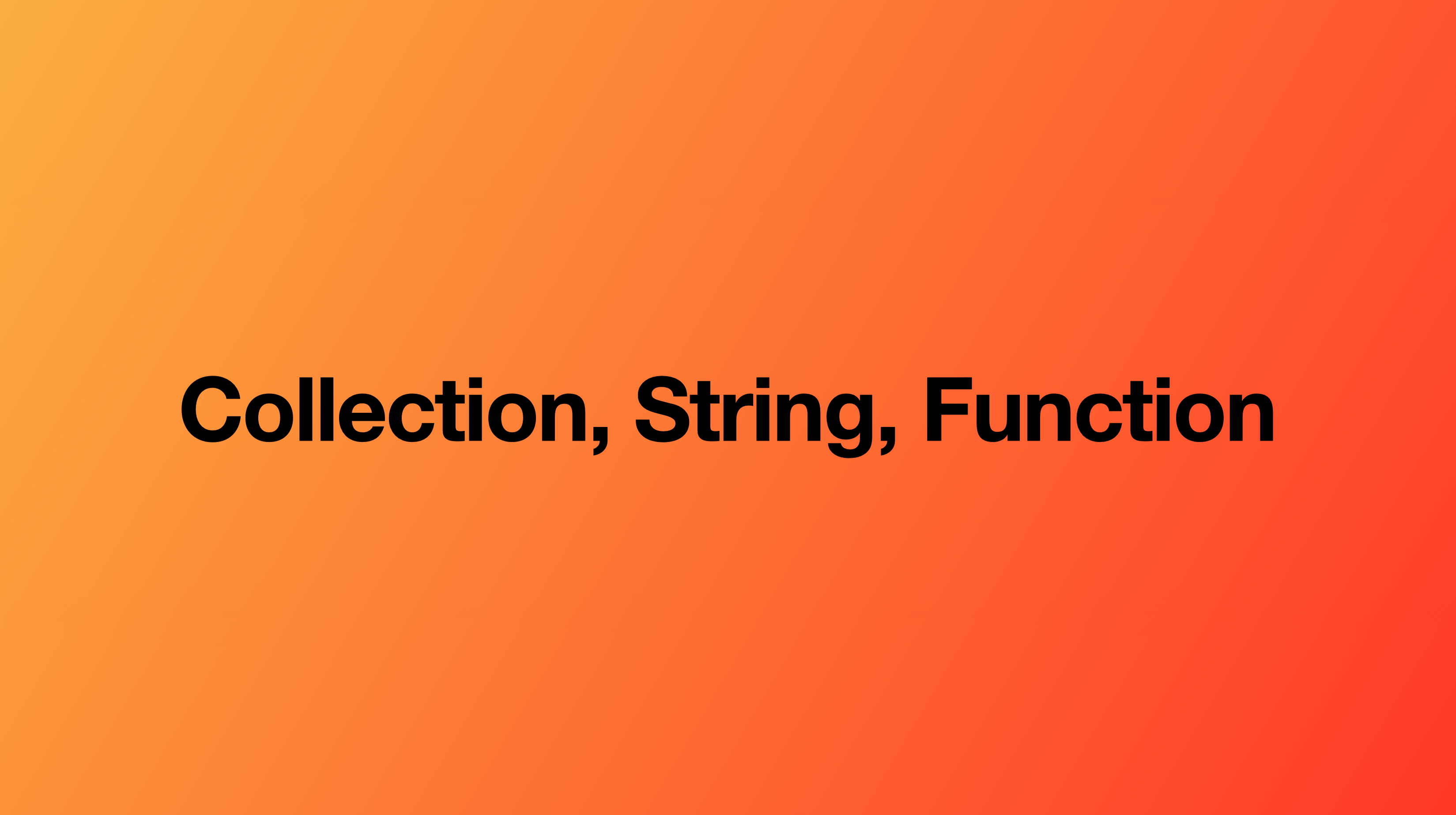
프로그래밍 언어에서 자주 사용하는 것들인 제어문, 문자열, 함수에 대해서 적어보려한다. 다른 언어와 많은 점이 다르지는 않기 때문에 한 포스팅에서 모두 알아보려 한다. 다만 Switch, String(unicode, index 문제 때문)의 경우는 조금 다르니 추가로 알아보는 것을 추천드린다. 함수는 사실 closure의 일종인데, 이는 이 다음 글에서 알아보도록 하고, 이번에는 일반적으로 아는 함수의 개념으로 이해하고 글을 읽어보자.
Control Statements
반복
- for-in
- Sequence를 iterate
- Sequence Protocol을 만족하는 모든 객체에서 사용가능
- Sequence 정의
- for-in loop로 순회할 수 있는 타입
- Sequence 종류
- Sequence 정의
- while
- 조건 문이 앞에 있기 때문에 최소 0회 실행
- repeat-while
- do-while과 유사
- 조건문 뒤에 있기 때문에 최소 1회 실행
분기
- if
- if, else if, else
- switch
- Pattern Matching
- 복잡한 조건에 따른 분기 가능
- break문 사용하지 않아도 각 case만 실행하고 종료됨
- 만약 아래까지 동작하고 싶다면
fallthrough키워드 활용
- 만약 아래까지 동작하고 싶다면
- 모든 case문은 반드시 실행문이 한줄이상 있어야 함
- 모든 경우에 대해 case문이 없다면 반드시
default필요 - Interval Matching
switch count { case 0: result = "no" case 1..<5: result = "few" default: result = "many" } - Value Binding
switch point { case (let x, 0): print("x축 위에 있음") case (0, let y): print("y축 위에 있음") case (let x, let y) where x == y: print("y = x 위에 있음") case (let x, let y) where x == -y: print("y = -x 위에 있음") case (let x, let y): print("좌표평면 위에 있음") }- where 절을 사용하면 추가 조건 확인이 가능함
Collection
- Value Type
- 다른 변수에 대입하면 복사됨
- argument로 넘겨도 복사됨
- argument로 collection을 넘겨서 변화주면 원하는 결과를 얻을 수 없음
- Objective-C의 경우 가능
Array
-
동일한 Type의 값을 저장할 수 있는 Ordered List
-
동일한 값이 다른 위치에서 반복적으로 낭로 수 있음
-
Foundation의 NSArray와 bridge
-
표현
let array: Array<SomeType>() let array: [SomeType] let array = [Int]() let array = Array<Int>() -
접근
array[0] = "A" array[1..3] = ["a", "b", "c"]
Set
- 동일한 type의 값을 저장할 수 있는 Collection
- 동일 값 존재 불가
- Foundation의 NSSet과 bridge
- 표현
let someSet: Set<Int>() let genres: Set<String> = ["Rock", "Classic", "Hip hop"]- type 명시가 없다면 array로 유추됨
- Element
- Element는 Hashable type이어야 함
- 기본적인 type(String, int, Double, Bool)은 Hashable
- Custom type을 Set에서 사용하려면 Hashable protocol 만족해야함
- Hashable
public func hash(into hasher: inout Hasher)- 어떤 value에 hashValue를 제공해서 value의 동일성을 검충하는데 사용
- value(struct)의 모든 값을 비교하는 것보다 빠름
Dictionary
-
key, value의 쌍을 저장하는 collection
-
key, value는 각각 type이 지정되어야 함
-
key는 dictionary안에서 unique하며, value의 identifier로 동작
-
key는 hashable
-
순서 없이 저장한다.
-
표현
let a: Dictionary<KeyType, ValueType> let b: [KeyType: ValueType] a = Dictionary<Int: String>() b = [Int: String]() var airports: [String, String] = ["XYZ": "Toronto", "DUB": "Dublin"] var airports = ["XYZ": "Toronto", "DUB": "Dublin"] -
메서드
- updateValue
- removeValue
String
- Extended String Delimiters
##""Hello World""#= Hello world- 특수문자들을 그대로 표현 가능
- String literal 선언을 #로 감쌈
- escape seqence
\n은 아래와 같이 사용 #"Line1\#nLine2#- Line1
- Line2
- Concatenating
+가능
- String Interpolation
"\(name) 는 \(food)을 먹습니다"
- Unicode
- String은 내부적으로 Unicode scalar value를 사용함
- 21-bit number
let precomposed: Character = "\u{D55C}" // 한 let decomposed: Character = "\u{1112}\u{1161}\u{11AB}" // ㅎ,ㅏ,ㄴ = 한으로 표현됨
- Index
- String.Index로 다룰 수 있음
- 해당 함수들로 다뤄야 함. 상당히 귀찮음
Function
-
일급 함수
- parameter로 사용가능
- return 값으로 사용가능
- 익명함수
-
argument label
- 호출하는 쪽에서 사용하는 이름
-
parameter name
- function 안에서 사용하는 이름
-
Variadic parameters
-
0개 이상의 특별한 타입을 나열해서 파라미터로 넘길 수 있음
-
...을 넣어서 사용 -
이렇게 선언된 경우 함수안에서 해당 type의 Array로 사용할 수 있음
func sum(values: Int...) -> Int { var result = 0 for value in values { result += value } return result } sum(10, 20, 30) // 60
-
-
inout parameters
- 일반적으로 함수에 전달된 파라미터의 변경은 함수안에서만 유효
- 하지만 function에서 바깥쪽 값을 바꿔야할 경우가 있음 (swap)
- inout으로 선언된 경우, 해당 변화가 호출된 쪽에 반영됨
